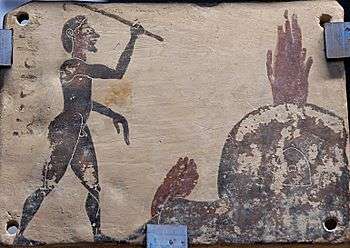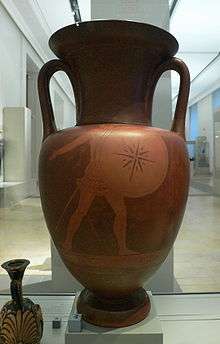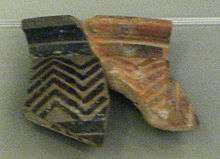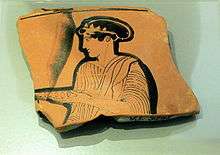Three-phase firing

Three-phase firing (or three-step firing) or iron reduction technique is a firing technique used in ancient Greek pottery production, specifically for painted vases. Already vessels from the Bronze Age feature the colouring typical of the technique, with yellow, orange or red clay and brown or red decoration. By the 7th century BC, the process was perfected in mainland Greece (Corinth and Athens) enabling the production of extremely shiny black-slipped surfaces, which led to the development of the black-figure and red-figure techniques, which dominated Greek vase painting until about 300 BC.
The conventional view, developed in modern times in view of a lack of contemporary accounts, was that painted Greek pottery received a single firing, after the shaped pot had been dried leather-hard and then painted. But the firing had three phases, designed to create the intended colours. Sometimes further painting in other colours was added after firing, especially in white-ground and Hellenistic vases. However, new studies instead provide material evidence that the pottery was made with two or more separate firings [1] in which the pottery is subjected to multiple firing stages. The conventional view is described in more detail below, but the possibility of different firings for the phases described should be kept in mind.
Stages of iron oxidation

All colours of Greek black-red vase painting are produced by the different concentrations of iron in the clay, and the different degrees to which that iron is oxidised during firing. Iron has the special feature of forming oxides of various colours, including grey Iron(II) oxide (FeO), red Iron(III) oxide (Fe2O3), and deep black magnetite (Fe3O4). Which of these types of oxidation is achieved depends on the availability of oxygen and the temperature of the reactive mix: a high oxygen content encourages the production of Fe2O3, while a lack of it tends to lead to the creation of FeO or Fe3O4. Thus, the colour of iron-rich clays can be influenced by controlling the atmosphere during firing, aiming for it to be either "reducing" (i.e. poor in oxygen and rich in carbon) or "oxidising" (i.e. rich in oxygen). This control is the essence of three-phase firing.
Vitrification and sintering
To achieve more than one colour on a given vase, a further trick is necessary: The black magnetite Fe3O4 has to be prevented from returning to matt red hematite Fe2O3. In other words, the areas to remain black have to be denied access to oxygen, their oxidised particles must be "sealed". This is achieved by using a further property of the clay: the vitrification point, i.e. the temperature at which the individual clay particles irreversibly merge, depends on the composition of the clay and on the particles contained in it.[2]

Smaller clay particles and a high calcium content lower the sintering point.[3] The production of finely varied painting slips was achieved through levigation and the subsequent scooping off of various layer.[4] The addition of "peptising" substances (i.e. substances that break up and separate the clay particles and prevent them from coagulating again) can further reduce particle size. Such substances include caustic soda (NaOH), ammonia (NH3), potash (K2CO3) and polyphosphates such as calgon (NaPO3)6: these attach themselves to the clay particles with strong hydrogen bonds and thus prevent them, in a similar way to tensides, from rejoining and coagulating again. In other words, the clay particles are now in a state of colloid suspension.[5]
Firing
Before firing, the clay vessels were densely stacked in the kiln. Since Attic pottery contains no glazes proper (i.e. ones that melt and vitrify completely), vessels could touch in the kiln. However, it was of major importance to achieve a good circulation of air/gas, so as to prevent misfiring.[6]
Phase 1: Kindling (oxidising)
Typical firing probably took place at a temperature of 850 to 975 degrees Celsius.[7] With constant firing of the kiln, such temperatures were reached after about 8 to 9 hours. During this process, the vessels in the oven initially lost whatever moisture remained in them. At a temperature of 500 °C, after 6 or 7 hours, true firing of the now red-hot vessels began. With a constant supply of oxygen and a still increasing temperature, the iron-rich shiny slip oxides and turned red, along with the rest of the vessel. During this process, the iron content is transformed into deep red hematite (Fe2O3). It is not necessary but highly likely that this kindling phase took place in an oxidising atmosphere: an oxygen-rich fire is likely in any case, since it is much more effective in producing heat. Further, the fact that reducing fires are extremely smoky would probably have been considered as undesirable, and was thus limited to the relatively short 2nd phase.
Phase 2: Reduction (vitrification of the shiny slip)

At about 900 °C, the oxygen supply is cut, creating reducing conditions, so that red hematite Fe2O3 turns to deep black magnetite Fe3O4. In antiquity this could be achieved through closing the air supply openings and adding non-dried brushwood and green wood, which would only burn incompletely, producing carbon monoxide (CO rather than CO2).[8] The temperature was held for some time, probably at about 945 °C, to assure a complete melting and sintering of the fine-particled paint slip.[9] Subsequently, the temperature sank below the sintering (vitrification) point of the painted slip again, while still in a reducing atmposphere.[10] Now, the slip is "sealed" and permits no further oxygen to react with its contents, so that the magnetite Fe3O4-oxides within it retain their black colour.
Phase 3: Reoxidation and cooling
During the final phase of firing, the aeration openings of the kiln are reopened: oxidising conditions are restored. Those areas of the vessels that were not sealed in phase 2 now reoxidise: black magnetite Fe3O4 turns back into red hematite Fe2O3.[11] After complete oxidation of the red areas, the kiln could be opened, its contents were then permitted to cool down slowly, and eventually removed.
Kiln control

A precondition for three-phase firing was a controllable kiln. Apparently, the necessary technology was developed in Corinth in the 7th century BC. Only the domed kilns with vent openings invented then allowed the production of black.figure, and subsequently of red-figure pottery.[12] The control of temperature could be assured visually by using a viewing hole, or through placing test pieces in the oven.[13]
References
- ↑ Walton, M., Trentelman, K., Cummings, M., Poretti, G., Maish, J., Saunders, D., Foran, B., Brodie, M., Mehta, A. (2013), Material Evidence for Multiple Firings of Ancient Athenian Red-Figure Pottery. Journal of the American Ceramic Society, 96: 2031–2035. doi: 10.1111/jace.12395
- ↑ The realisation that the base clay and the "paint" (slip) do not or only slightly differ in chemical terms was first published by Schumann (1942). It was later supported with spectrographic analyses by Noble (1969).
- ↑ This, and the fact that various sintering point are necessary to achieve several colours on the same vase, such as shiny black, red and deep red (or coral red, as visible e.g. on Exekias' famous Munich cup with Dionysos on a boat), was first recognised by Hofmann (1962).
- ↑ Detailed description in Winter (1959).
- ↑ Schumann (1942) used caustic soda and ammonia for his experiments, Hofmann (1962) tannins, Noble (1960/1965) mentions calgon (NaPO3)6) and potash. For antiquity, we can assume the use of potash, as it is created as a natural waste product when wood is burnt, e.g. in a potter's kiln.
- ↑ Especially from earlier periods, there are many incompletely reduced vases, with parts of the vessel remaining red, while other are completely black, although the whole vase is painted with the same slip. This could happen if the carbon.rich atmosphere failed to reach the surface or if the temperature was to low to seal the surface.
- ↑ E.g. Noble (1969) fired ancient pottery fragments, at above 975 °C the ancient black surfaces melted and reoxidised. Experiments with modern Attic clays have shown that at temperatures over 1005 °C they turn to a very light red colour, whereas below 1000 °C, colours very similar to that of ancient Attic vases are reached.
- ↑ In modern electrical ovens, wet sawdust can be added for this purpose. See Gustav Weiß: Keramiklexikon, entry "Reduktion im Elektroofen". Joseph Veach Noble also used sawdust: Noble (1960), p. 310-311.
- ↑ Noble (1960) suggests a "soaking period" of at least half an hour.
- ↑ The exact sintering point varies from clay to clay, in his experiments, Noble ended this phase at 875 °C (Noble 1960, p. 311).
- ↑ The different surface qualities of sintered/vitrified and unsintered surfaces are clearly depicted in electron microscope photographs in Hofmann (1962).
- ↑ Pictorial evidence for this is available in the form of paintings on votive tablets from Penteskoupha (now in the Antikensammlung of Berlin) depiciting potters in action, from the building of the kiln to the firing. Reconstruction of a kiln in Winter (1959). Description of modern workshops and kilns: Winter/Hampe (1962).
- ↑ Noble (1960/65) and Hofmann (1962) argue that visual control is sufficient. Farnsworth (1960) examined preserved test pieces found near excavated potting kilns from antiquity.
Bibliography
- Marie Farnsworth: Draw Pieces as Aids to Correct Firing. In: AJA 64 (1960), p. 72-75, pl. 16.
- U. Hofmann: The Chemical Basis of Ancient Greek Vase Painting. In: Angewandte Chemie 1 (1962), p. 341-350.
- Lisa C. Kahn and John C. Wissinger: "Re-creating and Firing a Greek Kiln." In: Papers on Special Techniques in Athenian Vases: Proceedings of a Symposium Held in Conjunction with the Exhibition The Colors of Clay. Ed. Kenneth D.S. Lapatin. Getty 2007.
- Joseph Veach Noble: The Technique of Attic Vase Painting. In: AJA 63 (1960).
- Joseph Veach Noble: The Techniques of Painted Attic Pottery. New York 1965.
- Ingeborg Scheibler: Griechische Töpferkunst. Herstellung, Handel und Gebrauch antiker Tongefäße. Ch. Beck, 2., rev. Edn.., Munich 1995. ISBN 3-406-39307-1
- Theodor Schumann: Oberflächenverzierung in der antiken Töpferkunst. Terra sigillata und griechische Schwarzrotmalerei. In: Berichte der deutschen keramischen Gesellschaft 32 (1942), p. 408-426.
- Adam Winter: Die Technik des griechischen Töpfers in ihren Grundlagen. In: Technische Beiträge zur Archäologie, Vol 1. Mainz (1959).
- Adam Winter, Roland Hampe: Bei Töpfern und Töpferinnen in Kreta, Messenien und Zypern. Mainz (1962).